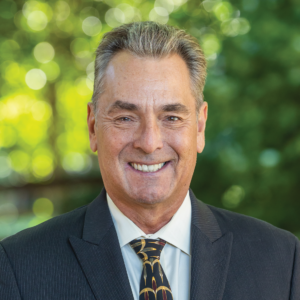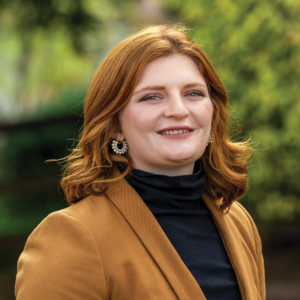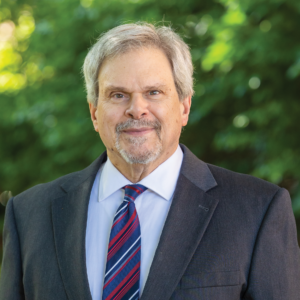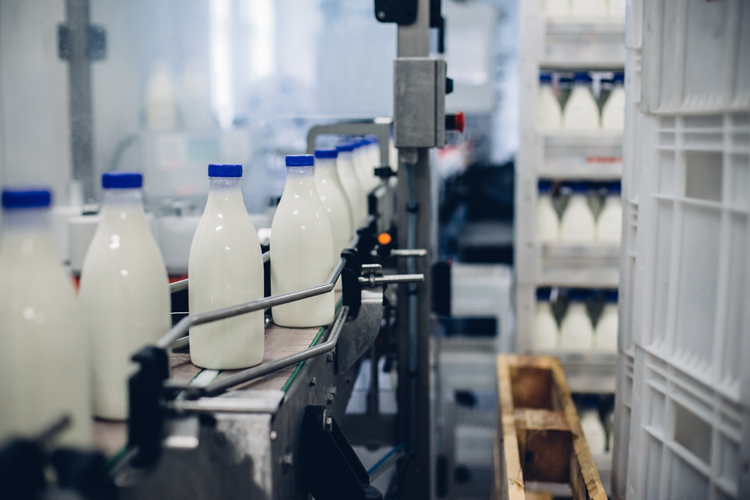NMPF Executive Vice President of Communications Alan Bjerga discusses the plethora of low- and no-lactose dairy products available to meet America’s nutritional needs in an interview with Dairy Radio Now. With societal concerns about equitable nutrition access informing conversations over the upcoming Dietary Guidelines, dairy needs to make it clear that it’s a nutrition solution for all, Bjerga says.
Author: Alan Bjerga
Congress can stand up for dairy’s nutrition
By Paul Bleiberg, Executive Vice President, Government Relations, National Milk Producers Federation
 Milk and dairy products supply 13 essential nutrients, including three that continue to be identified as nutrients of public health concern: calcium, potassium, and vitamin D.
Milk and dairy products supply 13 essential nutrients, including three that continue to be identified as nutrients of public health concern: calcium, potassium, and vitamin D.
The U.S. Department of Agriculture and the Department of Health and Human Services have historically recognized dairy’s important value in the Dietary Guidelines for Americans, which are updated once every five years and are due next year. The 2025-2030 Dietary Guidelines should continue to maintain dairy as a distinct food group, one that does not include plant-based imitation products that are not nutritionally equivalent to real milk and do not deliver dairy’s unique nutrient package.
But before the new guidelines are completed, Congress has the opportunity this year to highlight dairy as a nutrition powerhouse that cannot be easily replicated. Below the radar of a tumultuous presidential election year, the bipartisan DAIRY PRIDE Act, introduced in both houses of Congress, has steadily picked up additional support, with nearly 50 members now cosponsoring the House measure.
The DAIRY PRIDE Act directs the Food and Drug Administration (FDA) to enforce dairy standards of identity, which are rooted in dairy’s critical nutrient profile and the fact that milk is the product of an animal that can’t be replicated by substitute ingredients or concocted in a lab. Standards of identity were developed to promote honesty and fair dealing in the interest of consumers. These terms, including “milk” and “cheese,” have come to carry distinct meaning in the minds of consumers, with built-in expectations for nutritional values.
FDA’s continued failure to require the proper labeling of plant-based alternative products is a public health problem, plain and simple. When consumers make misguided, but well-intentioned, decisions to purchase imitation products in place of real dairy, the result will be more and more Americans not meeting the recommended intake of dairy outlined in the Dietary Guidelines for Americans. Multiple public health organizations have given voice to this concern, urging that young children not be fed most plant-based alternatives in place of real dairy as their nutrition profiles are largely not equivalent.
After years of anticipation, FDA issued proposed guidance last year intended to address this topic. But while the agency acknowledged the nutritional inferiority of most plant-based imitation products relative to real dairy, FDA still made no attempt to dissuade the makers of these products from labeling them using dairy terms – the true cause of consumer confusion.
The DAIRY PRIDE Act would fix this by deeming mislabeled dairy imitators as misbranded. It then would require FDA to promptly require the proper labeling of alternative products – without the unfettered use of dairy terms. This pro-public health, truth-in-labeling bill would spotlight dairy as a unique source of essential, underconsumed nutrients and can swiftly pass Congress before year’s end.
This column originally appeared in Hoard’s Dairyman Intel on Aug. 15, 2024.
NMPF’s Bjerga on the Dietary Guidelines
NMPF’s Executive Vice President for Communications & Industry Relations Alan Bjerga discusses the need to support dairy in the next iteration of the Dietary Guidelines for Americans. Dairy products provide high-quality nourishment and serve a wide swathe of Americans, and the guidelines themselves need to be the product of a science-based, deliberative process, Bjerga said in an interview with RFD-TV.
Much Good, Some Surprises in FMMO Plan, NMPF’s Cain Says
Stephen Cain, senior director of economic research and analysis for the National Milk Producers Federation, said NMPF is “very pleased with the recommendation that USDA has come up with” for Federal Milk Marketing Order Modernization. “Fundamentally, USDA agreed with our premise and methodology for all the changes we were asking for,” said Cain in an interview with the National Association of Farm Broadcasters.
Our tech needs defense from cyberattacks
By Clay Detlefsen, Chief Counsel, National Milk Producers Federation
 The National Milk Producers Federation (NMPF) has worked with federal agencies on cyber issues for more than two decades. While the priorities and likely types of threats have shifted as technology has advanced, food and agriculture entities must take cybersecurity in all its forms seriously.
The National Milk Producers Federation (NMPF) has worked with federal agencies on cyber issues for more than two decades. While the priorities and likely types of threats have shifted as technology has advanced, food and agriculture entities must take cybersecurity in all its forms seriously.
Last month, seven U.S. government agencies plus Canadian and British agencies worked together to create a fact sheet to address pro-Russian “hacktivist” activity among four of the nation’s 16 critical infrastructure sectors — water and wastewater, dams, energy, and food and agriculture.
Most people think of ransomware when they think of hackers. This involves people breaking into systems and demanding payment to unblock the data or system they have blocked. This is a very real concern, and the food processing industry alone has as many as 100 or more ransomware attacks per year. However, ransomware is not the food and agriculture sector’s only risk. This new government fact sheet focuses instead on industrial control systems that are attacked not to be extorted for ransom but rather to destroy the systems and negatively affect our nation’s critical infrastructure.
By exploiting software weaknesses, weak passwords, and passwords without two-factor authorization for internet-connected operational technology (OT) devices, pro-Russia hacktivists can cause disruptions that could range from mildly annoying to catastrophic. For example, already in 2024 pro-Russia hacktivists have manipulated access points known as human machine interfaces (HMIs) at water and wastewater systems in North America and Europe. The hackers altered machine settings, turned off alarm mechanisms, and changed administrative passwords to lock out operators.
While disruptions like these are — for now — smaller scale, a targeted attack that could disrupt or destroy enough infrastructure to cause chaos remains a real risk. For dairy, that risk is largely borne by processors, which have many more internet-connected systems than an average dairy farm. Still, the risk to farms rises as more dairies integrate high-tech and internet-connected devices into their operations. Processors and farms should be particularly diligent with any internet-connected devices that could cause serious harm if compromised, such as refrigeration equipment or rotary and robotic milking equipment.
The fact sheet linked above identifies numerous resources that help improve an entity’s cybersecurity, along with several recommendations that will help ward off ransomware attacks and attacks on OT. Among many holistic and system-wide mitigations, government agencies recommend three actions to take today if you have systems that may be open to attack:
- Immediately change all default passwords of OT devices.
- Limit the exposure of OT systems to the internet.
- Implement multifactor authentication for all access to the OT network.
NMPF will continue the dialog on this issue with federal partners and will keep the dairy industry informed. In the meantime, everyone is encouraged to share the government fact sheet with anyone who might find it useful.
This column originally appeared in Hoard’s Dairyman Intel on July 11, 2024.
Dairy Farmers See Advances in USDA’s FMMO Plan, NMPF’s Bjerga Says
Dairy farmers have reasons to be pleased with the draft proposal for Federal Milk Marketing Order modernization, NMPF Executive Vice President Alan Bjerga said in an interview with Dairy Radio Now. That said, the process isn’t complete. Farmers still have a 60-day comment period and a final producer vote before any final proposal is implemented. NMPF is ready to lead, as it has throughout, Bjerga said.
NMPF’s Bjerga on H5N1, Farm Bill
NMPF Executive Vice President for Communications & Industry Relations Alan Bjerga speaks on RFD-TV about dairy farmer challenges and their broader relationship with agriculture, ranging from H5N1 in dairy cattle to discussions of the 2024 Farm Bill in Washington. Success across all fronts will require communication and collaboration across agricultural sectors, he said. Meanwhile, NMPF is optimistic regarding the future of milk pricing, with a USDA plan on Federal Milk Marketing Order modernization expected within the next few weeks.
https://www.rfdtv.com/from-farm-bill-to-hpai-what-is-dairy-farmer-sentiment-looking-like
Work Continues to Strengthen Supply Chains

By Tony Rice, Director, Trade Policy, National Milk Producers Federation
America’s dairy producers rely on a global supply chain that is reliable, transparent, and predictable to thrive in the competitive global dairy market — a reality made apparent during the COVID-19 pandemic, when supply chain snarls created headaches for dairy and the entire global economy.
But while many pandemic-era export issues have eased, an emerging threat to secure, reliable U.S. rail shipping is worsening.
Organized crime groups are increasingly breaking into shipping containers headed from the Midwest to West Coast ports in search of high-value consumer products. That’s creating serious food safety issues and forcing exporters to return the cargo at a financial loss, with limited recourse for insurance claims.
The National Milk Producers Federation (NMPF), in collaboration with the U.S. Dairy Export Council (USDEC), is tackling the issue on two fronts. Exporters experiencing break-ins are being connected with relevant railroads to determine best practices to mitigate theft, including lock and tracking recommendations. Meanwhile, NMPF is engaged with the Federal Bureau of Investigations, Surface Transportation Board, Homeland Security Investigations, and rail police forces to identify options to heighten policing efforts and best practices for reporting break-ins. NMPF and USDEC are also pursuing new appropriations funding for a Homeland Security task force dedicated to addressing supply chain theft, with language specific to agricultural cargo.
Encouragingly, the Biden Administration is implementing new guardrails to prevent dairy exporters from having to deal with the sorts of record costs, unprecedented fees, and unpredictable shipping schedules that occurred during the pandemic.
That work started two years ago when NMPF fought hard to help shape and pass into law the Ocean Shipping Reform Act of 2022, which mitigated unfair and harmful carrier practices. The law’s far-reaching nature has resulted in a lengthy and deliberative implementation process — one to which NMPF has dedicated almost two years of engagement to ensure the rules are fair for dairy exporters.
That work paid off when the Federal Maritime Commission’s final rule on detention and demurrage billing practices took effect May 28. The rule reflects official recommendations from NMPF and USDEC, including important clarity on who should be billed, the time frames for billing, and a streamlined dispute process.
In tandem with upcoming rulemaking from the maritime commission on what determines a carrier’s unreasonable refusal to deal or negotiate, these statutes will bring much-needed stability to what has been a difficult shipping market to navigate. These developments are especially timely given the potential disruptions that a full reopening of the Red Sea would have on sailing schedules, as well as ongoing East Coast port labor negotiations.
While there are many moving pieces in shipping legislation, NMPF is engaging with Congress on two critical new bills. The bipartisan Ocean Shipping Reform Implementation Act would update supply chain data standards, and the Ocean Carrier Rail Storage Charges Act is a bill to clarify jurisdictional gaps between the Surface Transportation Board and the Federal Maritime Commission regarding fees oversight.
As dairy exporters navigate uncertain waters, NMPF and USDEC remain dedicated to supporting a resilient and secure supply chain. The work continues to ensure that U.S. dairy exporters continue to thrive in a dynamic global market.
This column originally appeared in Hoard’s Dairyman Intel on June 13, 2024.
FARM Biosecurity helps protect dairy’s future
 By Miquela Hanselman
By Miquela Hanselman Biosecurity may be more top-of-mind than ever in dairy herds in light of how industry practices are changing in reaction to the presence of the H5N1 virus in dairy cows. The National Dairy Farmers Assuring Responsible Management (FARM) Biosecurity Program has resources that can support dairy farmers as they face evolving animal care challenges.
The FARM Program launched its Biosecurity Program in 2021 via a cooperative agreement with the USDA National Animal Disease Preparedness and Response program. FARM Biosecurity builds on the existing FARM Animal Care Program and Secure Milk Supply (SMS) Plan, providing resources focused on protecting cattle and employee health.
The program includes both everyday biosecurity practices as well as enhanced biosecurity resources. The FARM Everyday Biosecurity Program focuses on preventing disease introduction and spread by building on the good husbandry practices dairy farmers have long included in animal care. Everyday biosecurity practices protect against common diseases like contagious mastitis, respiratory infections, and scours.
Enhanced biosecurity brings the practices developed under the SMS Plan into the FARM program. Though FARM Enhanced Biosecurity was developed to help ensure continuity of business during a foot and mouth disease outbreak, the concepts can help protect against other known disease threats, such as the current highly pathogenic avian influenza (HPAI) outbreak in dairy cattle.
Take steps now
We are still learning about how HPAI virus spreads among cattle, with more information expected as testing ramps up and federal agencies begin isolating data patterns. Below are some every day and enhanced biosecurity focus areas that help against the spread of many known diseases in cattle. These measures may also help prevent HPAI virus exposure to cattle and the people who care for them. Great first steps are identifying a line of separation, limiting animal movement as much as possible, using premovement testing, and having logs of visitors, deliveries, and animal movements.
Protecting the dairy from exposure:
- Minimize access of wild birds to cattle and their environment.
- Manage movements of cattle and their transport.
- Limit livestock contact to essential people.
Preventing cattle or calf exposure:
- Avoid feeding raw colostrum or milk to calves, cattle, and other mammals.
- Follow good milking practices.
- Separate new or returning animals and isolate sick animals.
- Sanitize milking equipment after use with new, returning, or sick cattle.
Precautions for animal caretakers:
- Avoid consuming unpasteurized (raw) milk and cheeses from suspect or confirmed HPAI cattle.
- Wear protective gear covering the eyes, nose, mouth, and hands when contacting infected animals, carcasses, milk, or manure.
The enhanced biosecurity prep guide and online training include key biosecurity concepts that can be used during the H5N1 outbreak.
Good biosecurity takes time and practice to be effective, but as current challenges show, more attention to it will be critical to our industry today and tomorrow. Building everyday practices into your routine and having an enhanced biosecurity plan can protect your animals, employees, and business from disease threats.
Visit nationaldairyfarm.com to learn more about biosecurity and access resources, and visit nmpf.org/hpai for the latest updates on HPAI in cattle.
This column originally appeared in Hoard’s Dairyman Intel on June 3, 2024.
Farm Bill Frameworks Share Common Ground
By Paul Bleiberg
Executive Vice President, Government Relations, National Milk Producers Federation
 After two years of hearings, listening sessions, and discussions, members of Congress are now making 2024 Farm Bill proposals. House Agriculture Committee Chairman GT Thompson, R-PA, and Senate Agriculture Committee Chairwoman Debbie Stabenow, D-MI, both began the month by releasing their initial farm bill framework documents and priorities.
After two years of hearings, listening sessions, and discussions, members of Congress are now making 2024 Farm Bill proposals. House Agriculture Committee Chairman GT Thompson, R-PA, and Senate Agriculture Committee Chairwoman Debbie Stabenow, D-MI, both began the month by releasing their initial farm bill framework documents and priorities.
Even a quick glance at them shows the two proposals have real differences. But they also share many similarities — and that’s especially true for dairy.
Dairy farmers continue to support the Dairy Margin Coverage program enacted in the 2018 Farm Bill. It has performed effectively for producers during challenging periods, and it’s a vast improvement over its predecessors. Both farm bill frameworks extend the program, including its discount option for those farmers who lock in coverage for five years. Just as important is an update to the program’s production history calculation to compensate producers based on more recent milk production. This is an area of common ground that builds on last year’s one-year farm bill extension.
Both proposals also have overlap in their natural resource programs, recognizing that voluntary, producer-led conservation programs are effective but oversubscribed. In that context, both committee chairs recommend using the new conservation funds enacted in the Inflation Reduction Act of 2022 to build baseline, ensuring these greater resources will remain available for years to come. Common ground also exists when it comes to maintaining the 50% of funding for livestock set aside with the Environmental Quality Incentives Program, which will allow dairy farmers to continue their ongoing sustainability work.
Looking overseas, both chambers include valuable provisions to counter harmful trade barriers by establishing a robust new process for safeguarding common food and beverage names in international markets. Both the House and Senate plans provide additional resources for animal health programs that protect farmers from animal diseases, a matter that’s gained urgency with the current U.S. H5N1 outbreak in dairy cattle. Finally, both bills continue the enduring connection between agriculture and nutrition, forgoing misguided proposals to separate the producer safety net from essential nutrition programs that are a key lifeline to families and households nationwide.
Each farm bill is unique, and so are the roads taken to complete them. But the House and Senate Agriculture Committee chairs have both taken vital first steps, and we are also pleased that Senate Agriculture Committee Ranking Member John Boozman, R-AR, plans to release his farm bill framework in short order. These proposals all pave the way for the work that will need to be done to arrive at one bipartisan, bicameral measure that can be signed into law. Dairy stands ready, as always, to be a force for common ground to help get the job done.
This column originally appeared in Hoard’s Dairyman Intel on May 20, 2024.
NMPF’s Yeiser Stepp Talks Biosecurity Best Practices
Emily Yeiser Stepp, Executive Director of the National Dairy Farmers Assuring Responsible Management (FARM) Program, discusses best practices in biosecurity as dairy farmers navigating a new federal order on testing and interstate animal movement in an interview with the National Association of Farm Broadcasters. “We still don’t know a lot about this virus and are taking action to limit that risk of virus spread, not only to protect our own dairy herds but also those poultry facilities that are being impacted, as well as protecting our dairy workers,” Yeiser Stepp said.
USDA Decision Time Nears for FMMOs
By Peter Vitaliano, Vice President, Economic Policy & Market Research, NMPF
The April 1 deadline for interested parties to submit post-hearing briefs summing up their arguments for changes to the Federal Milk Marketing Orders (FMMO) has passed. Now that participants in USDA’s record-length FMMO hearing having had their final say, it’s time for USDA to review the complete hearing record and formulate its recommended decision, which should be reported around July 1.
The National Milk Producers Federation offered by far the most comprehensive and constructive set of proposals for effecting long-overdue updates to the federal order pricing formulas. Our brief reemphasized that updating formulas to reflect the dynamically changing structure of the U.S. dairy industry is critically important for the order program to achieve its basic purposes of ensuring an adequate supply of milk for fluid milk use, promoting orderly marketing, and providing adequate prices to dairy farmers for doing so. NMPF’s five specific proposals put farmers first, in keeping with the FMMO mission. They also have very broad support from groups and individuals representing dairy farmer interests.
 By contrast, the major hearing participants representing processors opposed most of the hearing’s 21 proposals, including NMPF’s proposals to raise the Class III and Class IV skim milk component composition factors, remove barrel cheese from the protein component price formula, and update the Class I differentials to reflect current costs of supplying milk for fluid processing. Advocacy by proprietaries focused primarily on just two issues: the particularly high profile matters of the make allowances and the Class I mover.
By contrast, the major hearing participants representing processors opposed most of the hearing’s 21 proposals, including NMPF’s proposals to raise the Class III and Class IV skim milk component composition factors, remove barrel cheese from the protein component price formula, and update the Class I differentials to reflect current costs of supplying milk for fluid processing. Advocacy by proprietaries focused primarily on just two issues: the particularly high profile matters of the make allowances and the Class I mover.
While all parties to the hearing broadly agreed that the make allowances in the orders’ component pricing formulas need to be updated in stages — due largely to how much current costs likely exceed the current make allowances — hearing participants significantly disagreed on specifically how to do so. NMPF and its member cooperatives argued that USDA needs to have the authority and the directive to conduct regular mandatory, audited studies of manufacturing costs and yield factors so the industry, and dairy farmers in particular, can have confidence that the numbers are truly accurate — certainly more accurate than the voluntary cost studies that have more holes than Swiss cheese. All parties support mandatory studies, which almost certainly will be included in the upcoming farm bill. But proprietary manufacturer interests have requested that substantial increases, based only on voluntary studies, be fully implemented with a relatively short phase-in period, a move that would significantly harm dairy farmer incomes.
NMPF and other parties representing dairy farmer interests also universally support returning to the “higher of” Class I mover, a position equally strongly opposed by proprietary processor interests. No one supports the current “average of” mover, with its 74-cent per hundredweight fixed factor, but proprietary interests lined up behind keeping the average of mechanism with an adjustable factor that would mimic, with considerable lags, the higher of mover. This approach, done in the name of improving risk management, unfortunately mutes the immediate market signals the higher of approach sends. It also offers cold comfort to dairies that might go out of business because of a lower mover and don’t have the lag time to wait for a make-up adjustment later.
A low point in the hearing from the standpoint of farmer interests was reached when a group of proprietary fluid processors pushed back against NMPF’s carefully worked out proposal to increase the Class I differentials by proposing instead to eliminate the fixed portion of the current ones, which would effectively erase any difference between Class I and the manufacturing class prices in many orders and render them unworkable. It garnered no support from any other party.
But for all the controversy seen thus far, soon it will all be superseded by USDA’s plan. NMPF remains hopeful that careful thinking and attention to the purpose and mission of federal orders carries the day. We’re confident in a positive outcome.
This column originally appeared in Hoard’s Dairyman Intel on April 15, 2024.






